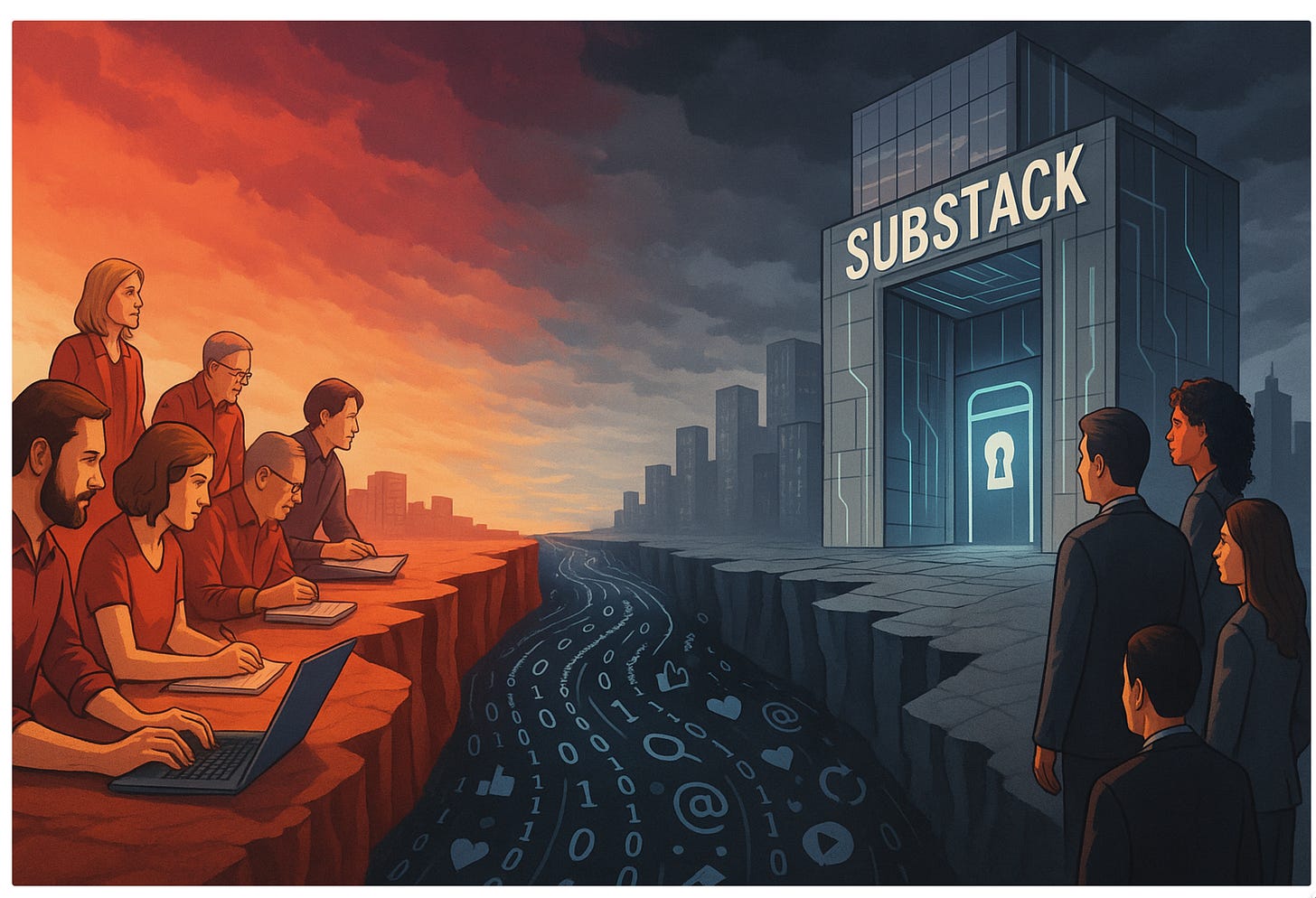I See the SubStack Culture Wars Have Started Up Again
Enriching and empowering through discoverability, or locking-in to roles as drones in a malevolent attention-hacking and harvesting grift? The unfinished battle for online publishing’s soul. To what extent is SubStack’s discoverability layer a mirage? & the three-body problem of writers, readers, & venture capitalists…
A lot of people who pass by my screen these days loathe SubStack.
Mostly, they have reasons.
Mostly, these reasons are pretty good.
We have: Molly White <https://www.citationneeded.news/substack-to-self-hosted-ghost/>, John Gruber <https://daringfireball.net/2025/08/substack_100_million_raise>, John Gruber <https://daringfireball.net/2025/08/the_substack_branding_and_faux_prestige_trap>, John Gruber <https://daringfireball.net/2024/11/regarding_and_well_against_substack>, John Gruber <https://daringfireball.net/linked/2025/08/02/cox-substack>, Anil Dash <https://www.anildash.com/2024/11/19/dont_call_it_a_substack/>, Ana Marie Cox <https://newsletter.anamariecox.com/archive/substack-did-not-see-that-coming/>, Molly White again <https://www.mollywhite.net/micro/entry/202504111009>, Matthew Ingram <https://mathewingram.com/2025/07/03/why-substack-shouldnt-be-the-future-of-online-publishing-2/>, Brittany Allen <https://mathewingram.com/2025/07/03/why-substack-shouldnt-be-the-future-of-online-publishing-2/>, Ana Marie Cox again <https://www.webpronews.com/ana-marie-cox-exits-substack-citing-fragility-and-rising-competition/>, Om Malik <https://om.co/2025/08/03/the-why-of-substack/>, Ana Marie Cox yet again <https://newsletter.anamariecox.com/archive/why-i-keep-writing-about-substack/>, and again <https://newsletter.anamariecox.com/archive/pushing-up-nazis/>/
And I know that there are MOAR that are not crossing my screen these days.
Substack’s promise mixes tech and psychology, pointing toward reach, revenue, and relevance in a media world hostile to independents. Yet its “discoverability layer,” stacked on a blog-email-tip-jar core, risks repeating Web 2.0’s slide into walled-garden, attention-harvesting platforms. The deeper question is the fate of public discourse itself: can we rebuild an open web that truly serves writers, readers, and democracy?.
That last is a little over-the-top.
But only a little.
Meanwhile, hanging out on SubStack, at least for now—even though it costs him and his posse $130,000 a year relative to alternatives—we have Matt Yglesias:
Matthew Yglesias: Concerns About SubStack <https://www.slowboring.com/p/a-cure-for-high-grocery-prices>: ‘I share John Gruber’s pique at things like an interviewer [Steve Inskeep] characterizing Paul Krugman as someone who “writes for Substack” rather than someone…use[ing] Substack’s software…. [But] this is not like an end of the world situation…. The bigger issue is… that Substack is very expensive compared to competing offerings…. We have a bit over 20,000 paid… at… [$7]/month, so we are paying a huge sum to Substack [$150 thousand/year out of our $1.5 million/year gross] compared to what [less than $20 thousand/year] we could get elsewhere…
That delta, for Matt and company, is the cost of three interns, two research associates, or one full-time programmer or social-media maestro not existing and not paid living wages. That is money that could be ploughed back into the Slow Boring effort, but is instead going to make SubStack “accidently” profitable this year
There is a countervailing factor.
First, Matt has SubStack’s discoverability layer working for him.
Second, SubStack has built software has a bunch of nice affordances that make things easier day-to-day.
And so, from Matt’s perspective:
Matthew Yglesias: Concerns About SubStack <https://www.slowboring.com/p/a-cure-for-high-grocery-prices>: ‘On the other hand, I do feel that Substack is a superior product. It has more features and non-trivial network effects. I currently have no plans to move…
But:
Matthew Yglesias: Concerns About SubStack <https://www.slowboring.com/p/a-cure-for-high-grocery-prices>: ‘Substack-the-company has [now] raised money from venture capitalists who are hoping for a large exit… incentiviz[ing]… big swings with low odds of a very high payoff…. As an established customer… thrilled with “slow and steady” growth, this is not… ideal…. I would love to see Substack working hard on continuous, small-scale improvement…. But Substack’s investors may be more interested in them becoming a short-form video platform with algorithmic distribution. Business is business… but that could eventually lead to us migrating elsewhere…
One who is trying to migrate elsewhere is Taylor Lorenz:
Taylor Lorenz: <https://bsky.app/profile/taylorlorenz.bsky.social/post/3lv66e3yhcc2v>: ‘Them: Get off substack Me: Ok I set up a Patreon. The features aren’t as good…. I’m willing to take a hit…. Do… more time consuming work…. Here’s where you can… support me. Once enough people hop over I’ll… jump Them: *crickets*.
A lot of people on here want to attack and punish creators (esp women and LGBTQ ppl) … rely[ing] on certain platforms to make a living, but… not… willing to support… in a way that allows them to leave…. If you’re not willing to put your money where your mouth… keep your criticisms on… the people who run these platforms, not… creators… trying to eek out a living. We deserve a better platform landscape…. That requires attacking people in power…. Wordpress is also a whole mess and unless you have millions of $ for marketing your content will simply be published into the void…
I would say that building a “better platform landscape” requires more than just attacking “the people who run these platforms” without an actual strategy for getting a better platform landscape, but let that pass. Moving on, Taylor struck a nerve. Examples:
Laura Jedeed: <https://bsky.app/profile/taylorlorenz.bsky.social/post/3lv66e3yhcc2v>: ‘THANK YOU SO MUCH FOR SAYING THIS. I moved to beehiiv. I lost money…. I moved back to Substack…. Being alive cost money. Randos… tell me I could do just fine on an alternate platform…. Not one of them has a newsletter…
And:
Ana Marie Cox: <https://bsky.app/profile/anamariecox.bsky.social/post/3lv6zf367rc2e>: ‘Substack is bad and creators should leave. But what Taylor describes here is real!... Taylor has a way to resolve this conflict! If we support her, maybe others will follow…. [But] Patreon is the best of only a few bad options…
So what do I think?
For me, the pitch that got me to move to SubStack was:
a weblog…
with email delivery as well…
and a normalized tip jar…
which may well revive this beneficial public-discourse side of the Stygian Swamp that is the internet…
so Chris, Hamish, and company really are attempting a mitzvah here…
and one might hope that the SubStack information ecology will be stable and expanding long-term, while the weblogging information ecology was not…
and if you jump to SubStack it will add a little to the their chances…
All that is much more true than not.
At the moment, I am balanced between:
(a) gratitude to SubStack for starting the ball rolling
(b) and getting others to “raise their game” as they copy its best features;
(c) belief that the cause of a less-irrational public sphere is worth supporting,
(d) and that chipping in 10% to the SubStack project is a way to do that support;
(e) hope that the SubStack “discoverability” layer will be a substantial positive;
(f) balanced by the “Nazi Bar” problem;
(g) and also the fear that there will, eventually, be a heel turn for SubStack,
(h) when Chris, Hamish, and company will be replaced by people whom the investors have concluded will do an enthusiastic job of malevolent attention-harvesting monetization;
(i) plus annoyance that PassPort has not yet launched.
And, right now, if you have a SubStack, please: Go to: Settings → Subscribers → … → Export:
Now you have your .csv file of subscribers: 2025-08-02-substack-subscribers-l5RQirajSomgmBDYk3GlJA.csv.
You can then go to any other email-newsletter-website-archive host to import. Hook your Stripe account. Tell SubStack not to charge and Stripe not to pay SubStack 10%. And there you are.
It would be wise to repeat this download every month, in case this option-to-export should someday vanish. You are not locked in. As Anil Dash writes: “the counter-argument… [of SubStack’s] convenience… I was more empathetic towards before great options like Ghost and Beehiiv and Medium even WordPress stepped up their game…”. Which they did. Once SubStack had pointed the way. (Which happened only after Ben Thompson with <http://stratechery.org> and PassPort had pointed the way first.)
Except that you are locked in, as people like Taylor Lorenz and Laura Jedeed find, because then you lose the SubStack discoverability layer.
My view: For most people, right now there is insufficient reason to incur the hassle-of-moving and loss-of-discoverability layer now, for SubStack remains, as Ana Marie Cox says, by far “the easiest way” to start and run a newsletter. And, on net, Chris, Hamish and company are undertaking a mitzvah.
However, some people—smart people—deny that the discoverability layer is worth much at all:
John Gruber: The Substack Branding & Faux Prestige Trap <https://daringfireball.net/2025/08/the_substack_branding_and_faux_prestige_trap>: ‘Substack has indies convinced that they build an audience… through… secret-sauce network effects, but I’ve seen no evidence that’s true. Writers… joining Substack are helping build Substack’s brand, not their own…. Less commented… but just as bad is the branding trap. Substack is a damn good name…. Almost all Substack publications look… deliberately, if subtly, Substack-branded, not per-publication or per-writer branded…. Only with Substack does anyone perceive creator branding as being subservient to the platform—something that ought to be seen merely as an interchangeable CMS…
And:
Anil Dash (2024): Don’t call it a SubStack <https://www.anildash.com/2024/11/19/dont_call_it_a_substack/>: ‘Substack wants you to… control your audience and distribution… own your content and voice…. It'd be a shame if something happened to those subscription dollars you're counting on, wouldn't it?… Links are powerful…. Substack tries to take credit for them…
But I have seen no statistical evidence that they are right. I have a bunch of anecdotal stories that they are wrong, and that the discoverability layer is in fact worth a substantial amount.
Look: I grok where they are coming from. What they want is a decentralized system of individual writers writing for occasions semi-regularly on their own websites, all linked together by discovering and referring and boosting one another as they argue and inform, and perhaps it will be a side-hustle for some and a source of resources to keep body-and-soul together for others.
Well, so do I. I want that too.
Lots of us who have been around this internet rodeo for a while want that too:
But we have experience with this.
Our experience with this has taught us that things with active discoverability-and-monetization layers—especially the clickbait attention-hacking advertising-supported ones—suck the life and energy out of the Open Web. Anil Dash, John Gruber, Ben Thompson, a number of others manage to make a good living at the weblogging-and-ancillary-services business. But they are few. More typical, I think, is an Ana Marie Cox, who we noted above writing that Patreon was the best of only a few bad options, and who we also find writing things like <https://newsletter.anamariecox.com/archive/substack-did-not-see-that-coming/>:
“Substack is still the easiest option for creating a newsletter, especially for creators without the time, tools, or tech fluency to self-host…”
“[My] conversations with editors at some of the largest news and politics Substack newsletters [found that] all… expressed frustration… a desire to leave, but fe[lt] constrained by the lack of infrastructure or certainty offered by other options…”
“A different newsletter platform isn’t all I want, because newsletters aren’t the answer…”
“We need a world where a social safety net protects risky writing. The idea that we can hustle our way to safety will only push us closer to collapse…”
“We don’t need better tools as much as we need each other…”
And yet we find her answers consist of:
“The market for alternatives will expand with demand. Make some demand…”
“If we support her, maybe other will follow her example! SUPPORT TAYLOR [LORENZ} ON PATREON….
Well, suppose John Perry Barlow and Friedrich von Hayek were right, and a combination of voluntarism in terms of contributions of work-hours and philanthropic gifts would support the creation of a discoverability layer. Suppose that layer would emerge spontaneously from the magic of the marketplace.
Then would not be in this fix, would we?
Then there would be no niche and no demand for a SubStack, would there?
Thus I find Cox (a) calling for a functional discoverability layer, (b) while rejecting the one we have, and (c) not fully conscious of the tension here:
“I do wish more of us had options—and support—for [working using]… different newsletter platform[. But that] isn’t all I want, because newsletters aren’t the answer to a disintegrating media ecosphere. We need a world where a social safety net protects risky writing. The idea that we can hustle our way to safety will only push us closer to collapse. We don’t need better tools as much as we need each other…”
“Ignore [SubStack’s]… posturing about free speech…. They’re leaning… into audience capture… audio, video, short-form posts, “discoverability”… keep[ing] readers in their app listening, watching, interacting—anything but reading newsletters in their inbox as God intended…
On the one hand she sees SubStack as a bad actor. It is pushing people to look at “audio, video, short-form posts, ‘discoverability’… listening, watching, interacting—anything but reading newsletters in their inbox as God intended…”.
On the other hand it is those bad-actor services that are the discoverability layer and that create the monetization revenue layer money flows that gives us “thousands of journalists locked-in because that’s how they hoped to make a living…”—i.e., they don’t want to abandon SubStack because they make (some) money from it.
And behind this, of course, there is the “Nazi Bar” problem.
I accept that if you add any discovery layer to Substack—to any internet network—that is more than a simple reliance on individual writer shout-outs, and you will very quickly run into a problem.
But for SubStack this problem is rather dire.
It is rather dire given that (a) the honchos of SubStack have a very different view of where the Overton Window should properly be than I do, (b) my view of where it should be is substantially to the right of the average writers, (c) the extraordinary variance of human opinion, and (d) the ability of the internet to bring the far-away and extreme to your face immediately. The problem thus produced is this: The attempt to cast a broad net, as far as recommendations for what people should read, winds up, remarkably quickly, in two places at once. First, the system suggests that people who read my stuff might also like to read writers who are very eager to classify others as a blight on humanity who need to be removed from the gene pool, humanely (or not) not.
Second, and at the same time, it also winds up recommending people who are very eager, for what seem like minor failures to toe some line, to drive others out in the wilderness to be food for Azazel.
This is not good.
The “Nazi Bar” problem is much worse than the “two-minute hate for small-scale trespass problem”, both (a) because it is a much bigger problem in American discourse today, and (b) because the right-wing lean of the SubStack honchos makes them vulnerable to it. They fail to see that they are platforming genuine bad actors (like Richard Hanania, for example), who then link to and recommend even worse actors, and so link-recommendations propagate. But both do emerge. And, as I said, they do emerge remarkably quickly. And they do emerge whenever you attempt a broad-net discoverability layer that is anything other then a defensive crouch.
SubStack’s defense that they are a publisher and not a content-curator holds no water.
They are publishers of newsletters. They are content curators of the discoverability laver. They are not either/or. They are both/and. My view is that they need to do a better job: more resources, more thoughtfulness, and less of a willingness to let themselves be gamed. They need to recognize that when one of their big backers is on record as telling Rick Perlstein that “I’m glad there’s OxyContin and video games to keep those people quiet…”, they are already deep under the water.
Critics, correctly and cogently, do lambaste Substack for its fees, its discoverability “trap,” and its willingness to play host to some of the worser actors in digital discourse.
And yet the vision of the imaginary good may turn out to be the enemy of the merely tolerable yet needed.
This is the Fallen Sublunary Sphere, after all.
And so, for most, the platform remains the path of least resistance—offering tools, audience, and a semblance of community. Moreover, for many—cough, cough, those without tenured jobs at respected research universities or similar lucky lighting strikes—it may be the only open path. I would prefer the Open Web of John Perry Barlow, Cory Doctorow, and Stewart Brand that seemed, when I was young, an intellectual utopia almost within our grasp? But, in the end, did the Open Web deliver?
Since it did not, we must carve ourselves what crutches we can. Substack, however, proposes to carry us on a sedan chair.
But will that sedan chair turn out to have a lock that is controlled only from the outside? I would say the chances are low. But I would also advise: keep your lock-picks oiled. Systems work best for those who both use, in Hirschman’s terms, voice while also making it very clear that they have the option of exit.
Remember when the web was open roads—or, rather, a place where we did not even need roads—and not tollbooths? The newsletter boom could replay the fall of Web 2.0, or could not. It is in our hands, as writers crave discoverability, and platforms crave rent, while venture capitalists crave ungodly amounts of lock-in money more than Smaug craves gold.





